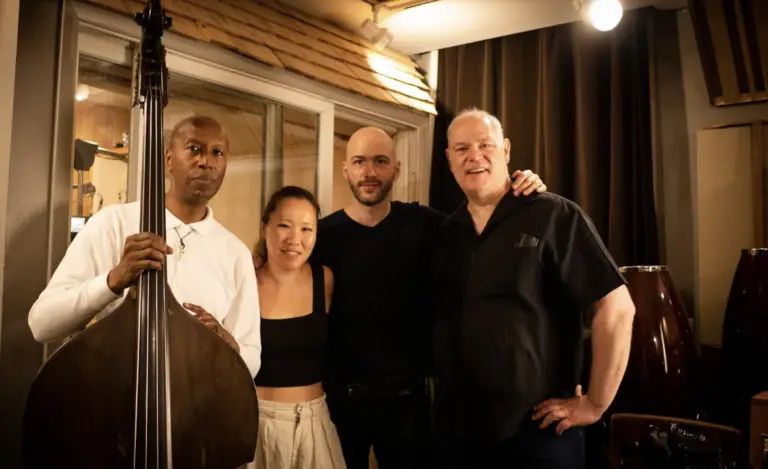New York-based jazz drummer Ilya Dynov released his debut album Bridges on April 16th, 2023. The album features Alex Norris on trumpet, Jihee Heo on piano, Lonnie Plaxico on bass, and Ilya Dynov on drums. Ilya Dynov reveals himself as an outstanding contender on the jazz scene. The album blends different jazz styles, balancing tradition and virtuosity with creative freedom. Thus, it showcases a mature harmony and expressive creativity.

Bridges consists of Dynov’s all original compositions and features an array of world class talent out of New York. Alongside Dynov on drums are the legendary bassist Lonnie Plaxico, extraordinary trumpeter Alex Norris, and exceptional pianist Jihee Heo. Bridges comprises 9 tracks: four in a piano trio setting, three as a quartet with trumpet, and two flavorful drum solos as “Intro” and “Finale” statements.
In terms of composition and exposition, the album exceeds typical expectations of a drummer-led band. It combines harmonically challenging pieces with convincing melodies brought to life with integrity, and a respect for American jazz tradition. Dynov’s excellent drumming technique is paired with a deep connection with the harmonic and melodic contributuons of his band mates. Through this, the result i s a exploration of a contemporary palate that, at the same time, respects the music of the forefathers.
The record consists of a wide range of compelling pieces. The “Intro” statement is immediately captivating to listeners and serves as a reflection of Dynov’s expertise. A suspenseful drum solo drifts in and out of intense crescendos and decrescendos, keeping the listener on the edge of their seat in anticipation. The short, somehow mysterious intro track, holds promise of a unique record to follow. The raw sound of the drum and interesting composition encourages the audience to listen to the next track.
The first ‘official’ song of the album, “Constellation,” opens with a compelling, raw base, which then leads to an exciting, smooth jazz melody. A riveting trumpet leads the bass, drums, and piano ensemble. “Constellation” largely embodies what jazz is truly about – listening to the song was akin to listening to an exciting conversation that one can’t help but be entirely invested in. Each instrument has its own voice and unique role within the song, and yet they all work together to create one coherent melody. The song ebbs and flows, taking the listener through fast and slow sections. Through rhythm, tone, and style changes, “Constellation” was extremely engaging, and embodied the instrumental conversation that is jazz.

“Drum and Berries,” the second track on the record, presented a smoother, slower melody than the previous tracks. Rather than an intense argument between instruments, “Drum and Berries” exemplified a flowing, cohesive conversation. The track opens with a gentle piano, accompanied by bass and drum. Throughout the slow jazz tune, the piano expertly navigated through the constraints posed by an ensemble, playing off the base while also embodying a classic jazz sound. Halfway through the song, the bass takes over, playing the tune set up by the piano in the first half. An exciting, raw drum solo follows, serving as a reminder of the intro track.
Something worth noting about the album is that each song is entirely unique, with its own personality. Following the first three tracks, “For Those We Love” plays off a more classic jazz sound than the other songs. A trumpet solo immediately engages listeners within the first few beats of the song, soon leading into a classical jazz melody. The tone of the trumpet, accompanied by a well-blended pairing of piano and drums, creates a somber, almost romantic energy. Unlike previous tracks, the trumpet takes the spotlight overpowering notes and rhythms. Rather, the simple notes and melody are compelling in their sim[licity and rawness.
“For Those We Love” seems to tell a story through the trumpet – the mood shifted throughout the song, sometimes embodying a somber narrative, other times presenting itself as bright and optimistic. Like previous tracks, instruments within the ensemble each took over the musical conversation in a contemporary jazz fashion.

A theme that was present throughout the album was the compelling and dramatic drum solo. The fifth track, “Blue” continued the suspenseful drum solos from the intro and “Drum and Berries.” A wonderfully unsettling, compelling, and raw drum solo emerged following a highly suspenseful, gradual crescendo. Through dramatic crescendos and decrescendos, the drums presented a contemporary mix of all sorts of sounds working together. The song itself seemed to ebb and flow, emerge and remerge, and changed throughout the track. The drums grew increasingly more spunky, ultimately resulting in an edgy tune with an upbeat melody, led by piano. “Blue” transitioned into a fast, compelling, and bright piano melody, the second half of the song completely different than the introduction.
Another highlight within the album is “68th Street,” a song largely reminiscent of classical jazz. The song emulates a beautiful ballad through its well-rounded, blooming melody. The piano seemed to convey a story about love. The bass and piano both act as soloists throughout the song, and effectively convey a calm, gorgeous melody that one can’t help but fall in love with.
Overall, “Bridges” is a highly versatile album that embodies all that is wonderful about jazz. Each song is compelling in its own right, and the album in its entirety serves as a valuable addition to the world of jazz.


Comments are closed.